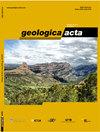晚variscan过铝质Valdepeñas岩体(伊比利亚中南部地区)
IF 2
4区 地球科学
Q2 GEOLOGY
引用次数: 3
摘要
瓦尔迪普纳斯深成岩体是卡塞雷斯-瓦尔迪普纳斯岩浆岩系(伊比利亚半岛中南部)的最东部露头。该地块由含堇青石的斑状二长花岗岩组成,可能属于所谓的“Mixta系列”花岗岩。Valdepenas二长花岗岩为镁质[FeO t/(FeO t+MgO)~0.76]、碱钙质[(Na 2 O+K 2 O)-CaO=7.8–8.5]和过铝质(A/CNK=1.14–1.20)。多元素和REE归一化模式与Nisa-Alburquerque Los Pedroches岩浆岩系中类似岩石的模式相当,与Montes de Toledo岩基的模式略有不同,均位于伊比利亚中南部地区。U-Pb锆石年龄为303±3Ma,与该侵入体的晚造山特征一致,与伊比利亚中南部地区的大多数花岗质过铝质侵入体一致。86 Sr/87 Sr 300Ma比值(0.707424–0.711253)、eNd 300Ma值(-5.53–-6.68)以及所研究岩石的全岩主元素和微量元素组成表明,瓦尔迪普那二长花岗岩的母岩浆可能来源于地壳变火成岩。Valdepenas二长花岗岩样品中发现的继承锆石岩芯的U-Pb年龄(552–650Ma)与伊比利亚中部下古生代变质火山岩和花岗质正片麻岩中经常发现的锆石岩芯相匹配,此外,还指出上新元古代变质火成岩基岩可能是岩浆源的原岩。根据独居石在过铝熔体中的溶解度,所研究的二长花岗岩的侵位温度估计为742–762℃。这项工作的结果将有助于更好地了解“Mixta系列”花岗岩的起源。本文章由计算机程序翻译,如有差异,请以英文原文为准。
The late-Variscan peraluminous Valdepeñas pluton (southern Central Iberian Zone)
The Valdepenas pluton is the easternmost outcrop of the Caceres-Valdepenas magmatic alignment (southern Central Iberian Zone). This massif is constituted by a cordierite-bearing porphyritic monzogranite and may be grouped within the so-called “Serie Mixta” granitoids. The Valdepenas monzogranite is of magnesian [FeO t /(FeO t +MgO)~0.76], alkali-calcic [(Na 2 O+K 2 O)–CaO=7.8–8.5] and peraluminous (A/CNK=1.14–1.20). Multielemental- and REE-normalized patterns are comparable to those of similar rocks in the Nisa- Alburquerque-Los Pedroches magmatic alignment, and slightly differ from those of the Montes de Toledo batholith, both in the southern Central Iberian Zone. The U-Pb zircon age of 303±3Ma is consistent with the late-orogenic character of the intrusion and is in accordance with most of the granitic peraluminous intrusions in the southern Central Iberian Zone. 86 Sr/ 87 Sr 300Ma ratios (0.707424–0.711253), eNd 300Ma values (-5.53 to -6.68) and whole-rock major and trace element compositions of the studied rocks, suggest that the parental magma of the Valdepenas monzogranite could derive from a crustal metaigneous source. The U-Pb ages (552–650Ma) of inherited zircon cores found in Valdepenas monzogranite samples match those often found in Lower Paleozoic metavolcanics and granitic orthogneisses of Central Iberia and, furthermore, point to Upper Neoproterozoic metaigneous basement rocks as possible protoliths at the magma source. Based on the solubility of monazite in peraluminous melts, the estimated emplacement temperature of the studied monzogranite is 742–762oC. The results obtained in this work would contribute to a better understanding of the origin of the “Serie Mixta” granitoids.
求助全文
通过发布文献求助,成功后即可免费获取论文全文。
去求助
来源期刊

Geologica Acta
地学-地质学
CiteScore
2.50
自引率
6.70%
发文量
13
审稿时长
>12 weeks
期刊介绍:
- Relevant conceptual developments in any area of the Earth Sciences.
- Studies presenting regional synthesis.
- Thematic issues or monographic volumes presenting the results from one or more research groups.
- Short papers reflecting interesting results or works in progress.
- Contributions and results from Research Projects, Workshops, Symposiums, Congresses and any relevant scientific activity related to Earth Sciences.
- Geologica Acta aims to stimulate rapid diffusion of results and efficient exchange of ideas between the widespread communities of Earth Science researchers (with special emphasis on Latinamerica, the Caribbean, Europe, the Mediterranean
 求助内容:
求助内容: 应助结果提醒方式:
应助结果提醒方式:


